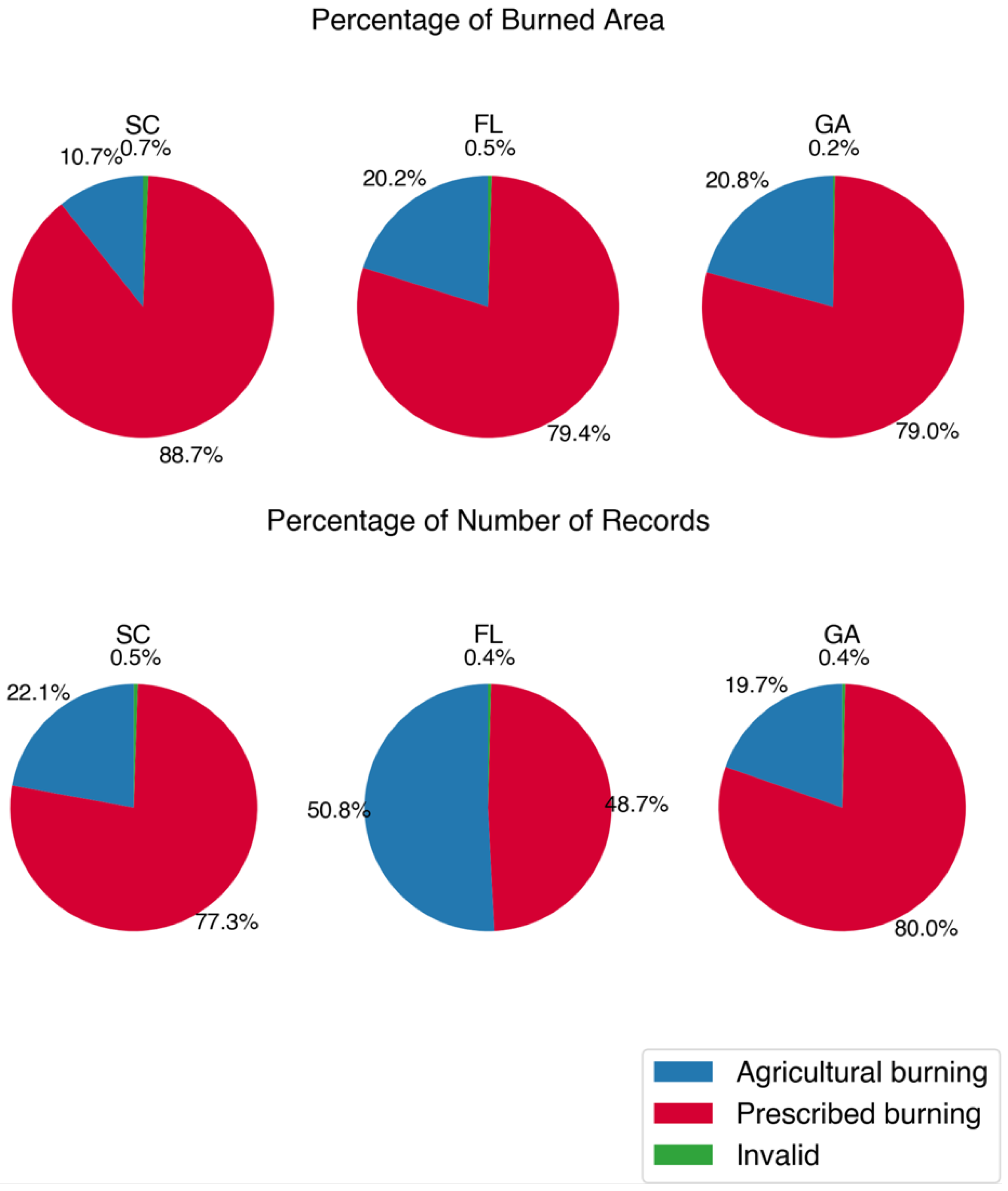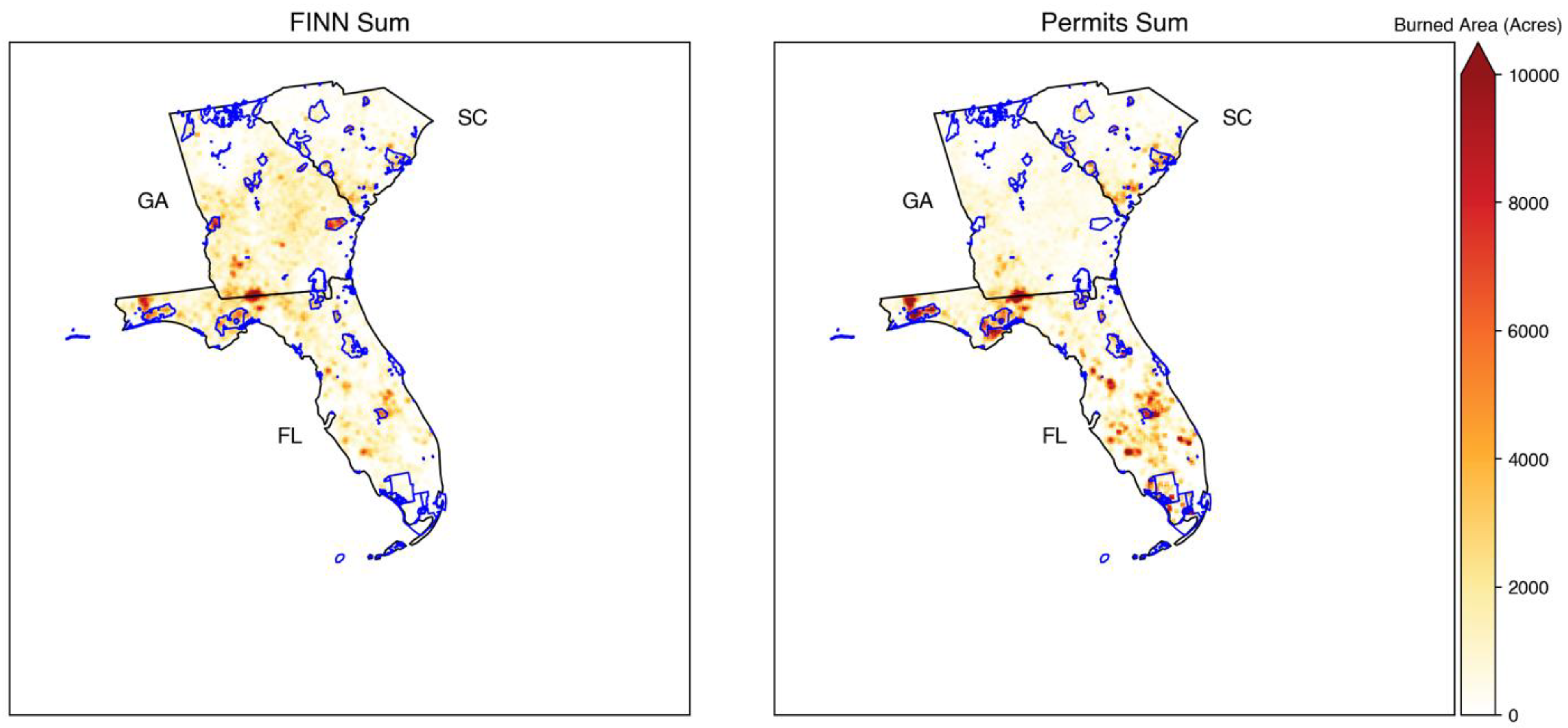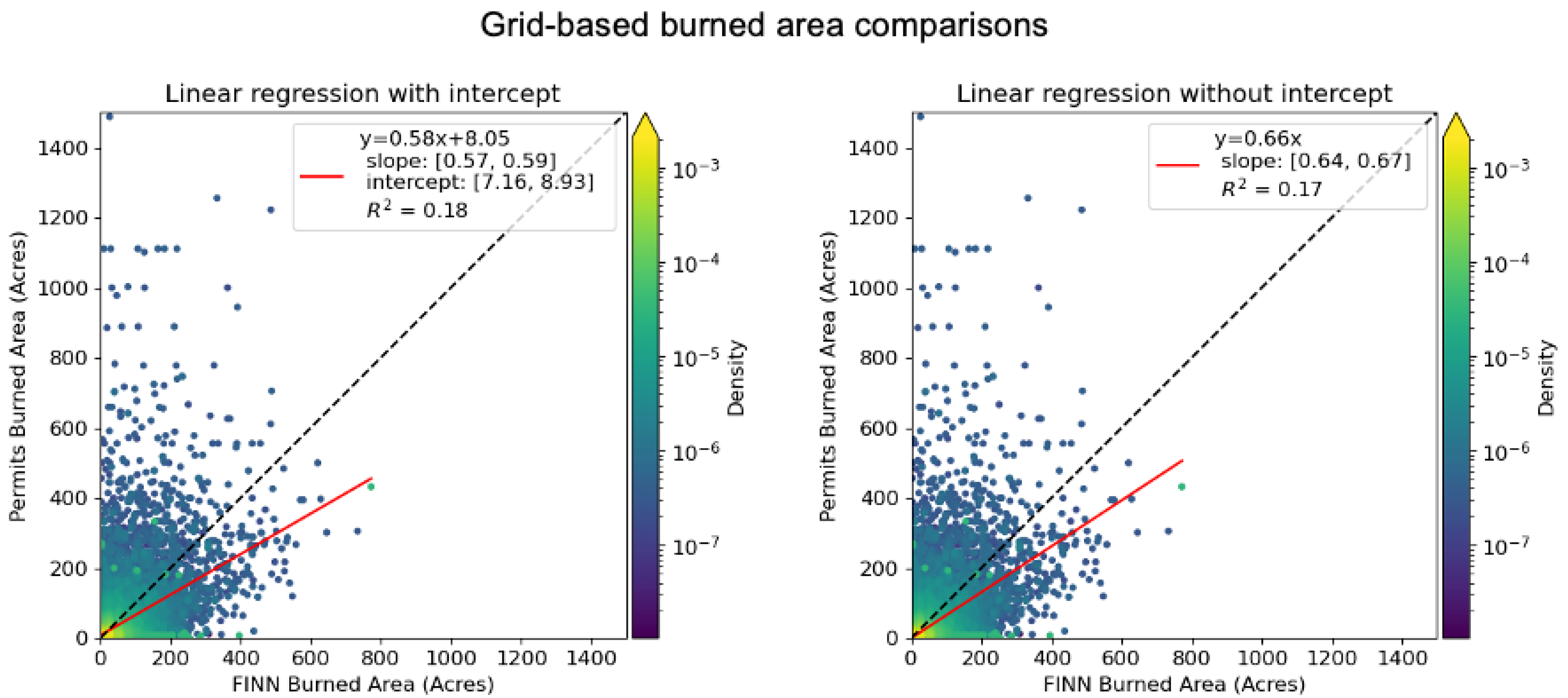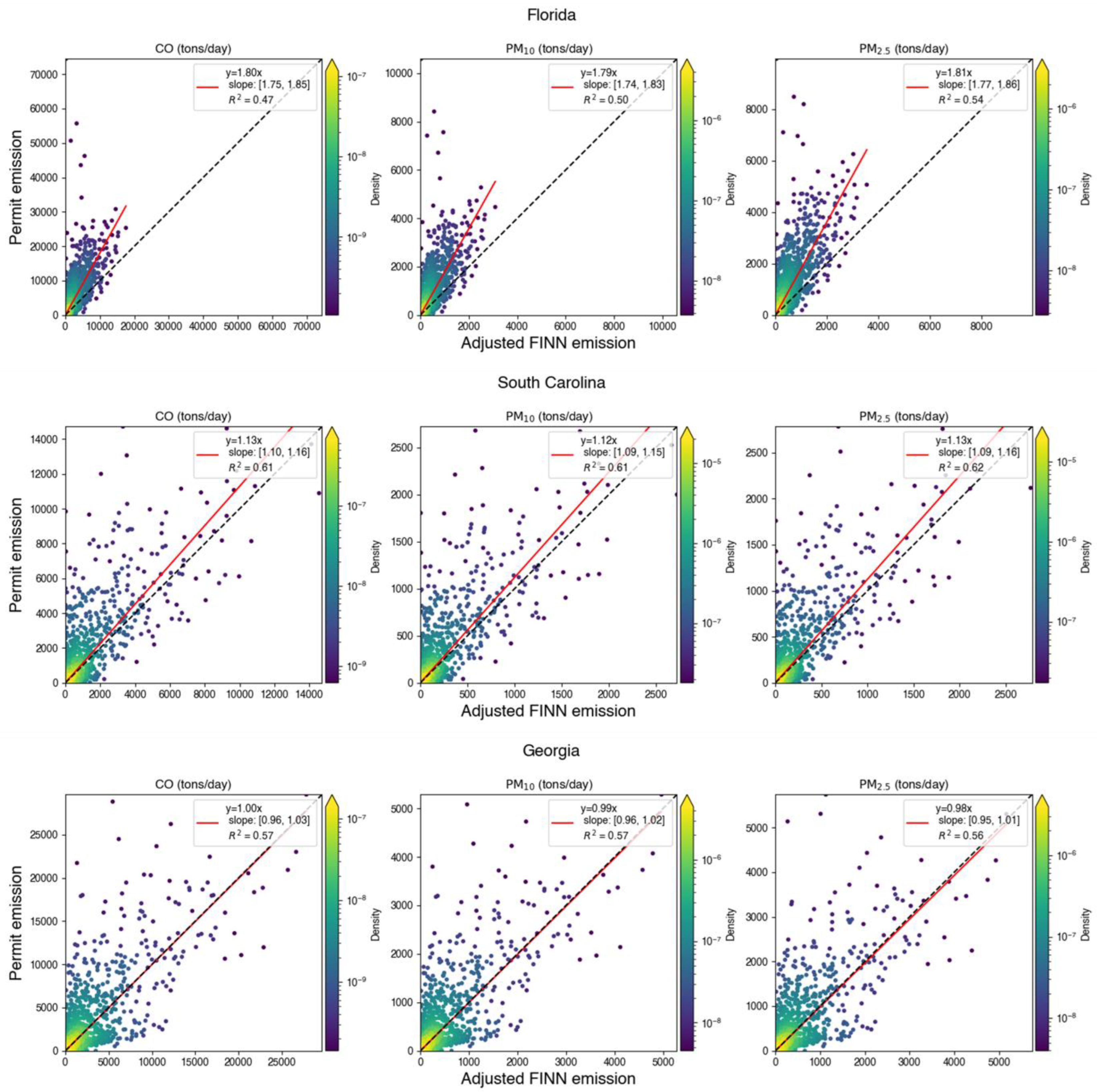An Analysis of Prescribed Fire Activities and Emissions in the Southeastern United States from 2013 to 2020
Abstract
:1. Introduction
2. Materials and Methods
2.1. State-Prescribed Burning Permit Records
2.2. Fire INventory from NCAR (FINN)
2.3. BlueSky Smoke Modeling Framework
3. Methods
3.1. Burn-Type Differentiation
3.1.1. Agricultural Burning Identification
3.1.2. Wildfire Detection Algorithm
3.2. Matching FINN-Prescribed Burning Records with Permits
3.2.1. Statewide Matching
3.2.2. Fire-to-Fire Matching
3.2.3. Grid-Based Burned Area Matching
4. Results
4.1. Burn-Type Differentiation
4.1.1. Agricultural Burning Identification
4.1.2. Wildfire Detection
4.1.3. Burn Types in FINN and Permits
4.2. Matching Prescribed Burning Records in FINN with Permits
4.3. Prescribed Burning Emissions
4.3.1. Emission Comparison between FINN and BlueSky
4.3.2. Prescribed Burning Emissions from Adjusted FINN Burned Area and Permits
4.3.3. Emissions Comparison with NEI
5. Discussion
5.1. Burn-Type Differentiation
5.2. Matching Prescribed Burning Records in FINN with Permits
5.3. Prescribed Burning Emissions
6. Conclusions
Supplementary Materials
Author Contributions
Funding
Data Availability Statement
Acknowledgments
Conflicts of Interest
References
- NIFC. Total Wildland Fires and Acres (1983–2021). Available online: https://www.nifc.gov/fire-information/statistics/wildfires (accessed on 27 June 2022).
- McKenzie, D.; Gedalof, Z.E.; Peterson, D.L.; Mote, P. Climatic change, wildfire, and conservation. Conserv. Biol. 2004, 18, 890–902. [Google Scholar] [CrossRef]
- Westerling, A.L.; Hidalgo, H.G.; Cayan, D.R.; Swetnam, T.W. Warming and earlier spring increase western US forest wildfire activity. Science 2006, 313, 940–943. [Google Scholar] [CrossRef] [PubMed]
- Stavros, E.N.; Abatzoglou, J.; Larkin, N.K.; McKenzie, D.; Steel, E.A. Climate and very large wildland fires in the contiguous western USA. Int. J. Wildland Fire 2014, 23, 899–914. [Google Scholar] [CrossRef]
- Running, S.W. Is global warming causing more, larger wildfires? Science 2006, 313, 927–928. [Google Scholar] [CrossRef] [PubMed]
- US Environmental Protection Agency. Comparative Assessment of the Impacts of Prescribed Fire Versus Wildfire (CAIF): A Case Study in the Western US; US Environmental Protection Agency: Washington, DC, USA, 2021.
- Jaffe, D.A.; O’Neill, S.M.; Larkin, N.K.; Holder, A.L.; Peterson, D.L.; Halofsky, J.E.; Rappold, A.G. Wildfire and prescribed burning impacts on air quality in the United States. J. Air Waste Manag. Assoc. 2020, 70, 583–615. [Google Scholar] [CrossRef] [PubMed]
- Melvin, M.A. 2021 National Prescribed Fire Use Report. Available online: https://www.stateforesters.org/wp-content/uploads/2023/01/2021-National-Rx-Fire-Use-Report_FINAL.pdf (accessed on 8 May 2023).
- Seiler, W.; Crutzen, P.J. Estimates of gross and net fluxes of carbon between the biosphere and the atmosphere from biomass burning. Clim. Chang. 1980, 2, 207–247. [Google Scholar] [CrossRef]
- Possell, M.; Bell, T.L. The influence of fuel moisture content on the combustion of Eucalyptus foliage. Int. J. Wildland Fire 2012, 22, 343–352. [Google Scholar] [CrossRef]
- Ma, Y.; Yang, S.; Zhu, Z.; Wang, G.; Tigabu, M.; Guo, Y.; Zheng, W.; Guo, F. Emissions of gaseous pollutants released by forest fire in relation to litter fuel moisture content. Atmos. Environ. 2022, 284, 119215. [Google Scholar] [CrossRef]
- Tihay-Felicelli, V.; Santoni, P.; Gerandi, G.; Barboni, T. Smoke emissions due to burning of green waste in the Mediterranean area: Influence of fuel moisture content and fuel mass. Atmos. Environ. 2017, 159, 92–106. [Google Scholar] [CrossRef]
- Zhang, X.; Kondragunta, S. Temporal and spatial variability in biomass burned areas across the USA derived from the GOES fire product. Remote Sens. Environ. 2008, 112, 2886–2897. [Google Scholar] [CrossRef]
- Giglio, L.; Randerson, J.T.; Van Der Werf, G.R. Analysis of daily, monthly, and annual burned area using the fourth-generation global fire emissions database (GFED4). J. Geophys. Res. Biogeosci. 2013, 118, 317–328. [Google Scholar] [CrossRef]
- Wiedinmyer, C.; Akagi, S.; Yokelson, R.J.; Emmons, L.; Al-Saadi, J.; Orlando, J.; Soja, A. The Fire INventory from NCAR (FINN): A high resolution global model to estimate the emissions from open burning. Geosci. Model Develop. 2011, 4, 625–641. [Google Scholar] [CrossRef]
- Wiedinmyer, C.; Kimura, Y.; McDonald-Buller, E.C.; Emmons, L.K.; Buchholz, R.R.; Tang, W.; Seto, K.; Joseph, M.B.; Barsanti, K.C.; Carlton, A.G.; et al. The Fire Inventory from NCAR version 2.5: An updated global fire emissions model for climate and chemistry applications. EGUsphere 2023, 2023, 1–45. [Google Scholar] [CrossRef]
- Zhang, X.; Kondragunta, S.; Ram, J.; Schmidt, C.; Huang, H.C. Near-real-time global biomass burning emissions product from geostationary satellite constellation. J. Geophys. Res. Atmos. 2012, 117. [Google Scholar] [CrossRef]
- Wooster, M.J. Small-scale experimental testing of fire radiative energy for quantifying mass combusted in natural vegetation fires. Geophys. Res. Lett. 2002, 29, 21–24. [Google Scholar] [CrossRef]
- Koplitz, S.N.; Nolte, C.G.; Pouliot, G.A.; Vukovich, J.M.; Beidler, J. Influence of uncertainties in burned area estimates on modeled wildland fire PM2. 5 and ozone pollution in the contiguous US. Atmos. Environ. 2018, 191, 328–339. [Google Scholar] [CrossRef]
- Zeng, T.; Liu, Z.; Wang, Y. Large fire emissions in summer over the southeastern US: Satellite measurements and modeling analysis. Atmos. Environ. 2016, 127, 213–220. [Google Scholar] [CrossRef]
- Huang, R.; Zhang, X.; Chan, D.; Kondragunta, S.; Russell, A.G.; Odman, M.T. Burned area comparisons between prescribed burning permits in southeastern United States and two satellite-derived products. J. Geophys. Res. Atmos. 2018, 123, 4746–4757. [Google Scholar] [CrossRef]
- Larkin, N.K.; Raffuse, S.M.; Huang, S.; Pavlovic, N.; Lahm, P.; Rao, V. The comprehensive fire information reconciled emissions (CFIRE) inventory: Wildland fire emissions developed for the 2011 and 2014 US National Emissions Inventory. J. Air Waste Manag. Assoc. 2020, 70, 1165–1185. [Google Scholar] [CrossRef]
- McClure, C.D.; Pavlovic, N.R.; Huang, S.; Chaveste, M.; Wang, N. Consistent, high-accuracy mapping of daily and sub-daily wildfire growth with satellite observations. Int. J. Wildland Fire 2023. [Google Scholar] [CrossRef]
- Larkin, N.K.; O’Neill, S.M.; Solomon, R.; Raffuse, S.; Strand, T.; Sullivan, D.C.; Krull, C.; Rorig, M.; Peterson, J.; Ferguson, S.A. The BlueSky smoke modeling framework. Int. J. Wildland Fire 2009, 18, 906–920. [Google Scholar] [CrossRef]
- Florida Forest Service. Florida Forest Service/Divisions & Offices/Home—Florida Department of Agriculture & Consumer Services. Available online: https://www.fdacs.gov/Divisions-Offices/Florida-Forest-Service (accessed on 6 April 2023).
- South Carolina Forestry Commission. Home—South Carolina Forestry Commission. Available online: https://www.scfc.gov/ (accessed on 6 April 2023).
- Georgia Forestry Commission. Available online: https://gatrees.org (accessed on 6 April 2023).
- Google. Available online: https://developers.google.com/maps/documentation/geocoding/overview (accessed on 6 April 2023).
- Fu, Y.; Li, R.; Wang, X.; Bergeron, Y.; Valeria, O.; Chavardès, R.D.; Wang, Y.; Hu, J. Fire detection and fire radiative power in forests and low-biomass lands in Northeast Asia: MODIS versus VIIRS Fire Products. Remote Sens. 2020, 12, 2870. [Google Scholar] [CrossRef]
- NOAA. Gridded Meteorological Data Archives NAM 12 km. Available online: https://www.ready.noaa.gov/archives.php (accessed on 19 May 2023).
- Skamarock, W.C.; Klemp, J.B.; Dudhia, J.; Gill, D.O.; Liu, Z.; Berner, J.; Wang, W.; Powers, J.G.; Duda, M.G.; Barker, D.M. A description of the advanced research WRF model version 4. Natl. Cent. Atmos. Res. 2019, 145, 145. [Google Scholar]
- Ottmar, R.D.; Sandberg, D.V.; Riccardi, C.L.; Prichard, S.J. An overview of the fuel characteristic classification system—Quantifying, classifying, and creating fuelbeds for resource planning. Can. J. For. Res. 2007, 37, 2383–2393. [Google Scholar] [CrossRef]
- Deeming, J.E. National Fire-Danger Rating System; Rocky Mountain Forest and Range Experiment Station; Forest Service: Washington, DC, USA, 1972; Volume 84.
- Ottmar, R.D.; Burns, M.F.; Hall, J.N.; Hanson, A.D. CONSUME: Users Guide; Gen. Tech. Rep. PNW-GTR-304; US Department of Agriculture, Forest Service, Pacific Northwest Research Station: Portland, OR, USA, 1993; p. 304.
- Prichard, S.J.; O’Neill, S.M.; Eagle, P.; Andreu, A.G.; Drye, B.; Dubowy, J.; Urbanski, S.; Strand, T.M. Wildland fire emission factors in North America: Synthesis of existing data, measurement needs and management applications. Int. J. Wildland Fire 2020, 29, 132–147. [Google Scholar] [CrossRef]
- Anderson, G.K.; Sandberg, D.V.; Norheim, R.A. Fire Emission Production Simulator (FEPS) User’s Guide. Available online: https://www.fs.usda.gov/pnw/fera/feps/FEPS_users_guide.pdf (accessed on 19 May 2023).
- Dennis, A.; Fraser, M.; Anderson, S.; Allen, D. Air pollutant emissions associated with forest, grassland, and agricultural burning in Texas. Atmos. Environ. 2002, 36, 3779–3792. [Google Scholar] [CrossRef]
- Homer, C.H.; Fry, J.A.; Barnes, C.A. The national land cover database. US Geol. Surv. Fact Sheet 2012, 3020, 1–4. [Google Scholar]
- Ketchen, D.J.; Shook, C.L. The application of cluster analysis in strategic management research: An analysis and critique. Strateg. Manag. J. 1996, 17, 441–458. [Google Scholar] [CrossRef]
- Urbanski, S.; Hao, W.; Nordgren, B. The wildland fire emission inventory: Western United States emission estimates and an evaluation of uncertainty. Atmos. Chem. Phys. 2011, 11, 12973–13000. [Google Scholar] [CrossRef]
- Schroeder, W.; Ellicott, E.; Ichoku, C.; Ellison, L.; Dickinson, M.B.; Ottmar, R.D.; Clements, C.; Hall, D.; Ambrosia, V.; Kremens, R. Integrated active fire retrievals and biomass burning emissions using complementary near-coincident ground, airborne and spaceborne sensor data. Remote Sens. Environ. 2014, 140, 719–730. [Google Scholar] [CrossRef]
- NIFC. Wildland Fire Location Full History. Available online: https://data-nifc.opendata.arcgis.com/datasets/nifc::wfigs-wildland-fire-locations-full-history/about (accessed on 7 June 2022).
- Stockwell, C.; Veres, P.; Williams, J.; Yokelson, R. Characterization of biomass burning emissions from cooking fires, peat, crop residue, and other fuels with high-resolution proton-transfer-reaction time-of-flight mass spectrometry. Atmos. Chem. Phys. 2015, 15, 845–865. [Google Scholar] [CrossRef]
- Stockwell, C.; Yokelson, R.; Kreidenweis, S.; Robinson, A.; DeMott, P.; Sullivan, R.; Reardon, J.; Ryan, K.; Griffith, D.; Stevens, L. Trace gas emissions from combustion of peat, crop residue, domestic biofuels, grasses, and other fuels: Configuration and Fourier transform infrared (FTIR) component of the fourth Fire Lab at Missoula Experiment (FLAME-4). Atmos. Chem. Phys. 2014, 14, 9727–9754. [Google Scholar] [CrossRef]
- Akagi, S.; Yokelson, R.J.; Burling, I.; Meinardi, S.; Simpson, I.; Blake, D.R.; McMeeking, G.; Sullivan, A.; Lee, T.; Kreidenweis, S. Measurements of reactive trace gases and variable O 3 formation rates in some South Carolina biomass burning plumes. Atmos. Chem. Phys. 2013, 13, 1141–1165. [Google Scholar] [CrossRef]
- Yokelson, R.J.; Burling, I.; Gilman, J.; Warneke, C.; Stockwell, C.; De Gouw, J.; Akagi, S.; Urbanski, S.; Veres, P.; Roberts, J. Coupling field and laboratory measurements to estimate the emission factors of identified and unidentified trace gases for prescribed fires. Atmos. Chem. Phys. 2013, 13, 89–116. [Google Scholar] [CrossRef]
- Akagi, S.; Yokelson, R.J.; Wiedinmyer, C.; Alvarado, M.; Reid, J.; Karl, T.; Crounse, J.; Wennberg, P. Emission factors for open and domestic biomass burning for use in atmospheric models. Atmos. Chem. Phys. 2011, 11, 4039–4072. [Google Scholar] [CrossRef]
- Byun, D.; Schere, K.L. Review of the governing equations, computational algorithms, and other components of the Models-3 Community Multiscale Air Quality (CMAQ) modeling system. Appl. Mech. Rev. 2006, 59, 51–77. [Google Scholar] [CrossRef]
- Briggs, G.A. Plume rise and buoyancy effects. Atmos. Sci. Power Prod. 1984, 327, 366. [Google Scholar]
- Fast, J.; Gustafson, W., Jr.; Easter, R.; Zaveri, R.; Barnard, J.; Chapman, E.; Grell, G.; Peckham, S. Evolution of ozone, particulates, and aerosol direct forcing in an urban area using a new fully-coupled meteorology, chemistry, and aerosol model. J. Geophys. Res 2006, 111, D21305. [Google Scholar] [CrossRef]
- Freitas, S.R.; Longo, K.M.; Chatfield, R.; Latham, D.; Silva Dias, M.A.F.; Andreae, M.O.; Prins, E.; Santos, J.C.; Gielow, R.; Carvalho, J.A., Jr. Including the sub-grid scale plume rise of vegetation fires in low resolution atmospheric transport models. Atmos. Chem. Phys. 2007, 7, 3385–3398. [Google Scholar] [CrossRef]
- Val Martin, M.; Logan, J.A.; Kahn, R.A.; Leung, F.Y.; Nelson, D.L.; Diner, D.J. Smoke injection heights from fires in North America: Analysis of 5 years of satellite observations. Atmos. Chem. Phys. 2010, 10, 1491–1510. [Google Scholar] [CrossRef]
- Sofiev, M.; Ermakova, T.; Vankevich, R. Evaluation of the smoke-injection height from wild-land fires using remote-sensing data. Atmos. Chem. Phys. 2012, 12, 1995–2006. [Google Scholar] [CrossRef]
- EPA. 2014 National Emissions Inventory (NEI) Data. Available online: https://www.epa.gov/air-emissions-inventories/2014-national-emissions-inventory-nei-data (accessed on 13 April 2023).
- EPA. 2017 National Emissions Inventory (NEI) Data. Available online: https://www.epa.gov/air-emissions-inventories/2017-national-emissions-inventory-nei-data (accessed on 13 April 2023).
- Auch, R.F.; Wellington, D.F.; Taylor, J.L.; Stehman, S.V.; Tollerud, H.J.; Brown, J.F.; Loveland, T.R.; Pengra, B.W.; Horton, J.A.; Zhu, Z. Conterminous United States land-cover change (1985–2016): New insights from annual time series. Land 2022, 11, 298. [Google Scholar] [CrossRef]
- Wickham, J.; Stehman, S.V.; Sorenson, D.G.; Gass, L.; Dewitz, J.A. Thematic accuracy assessment of the NLCD 2016 land cover for the conterminous United States. Remote Sens. Environ. 2021, 257, 112357. [Google Scholar] [CrossRef]
- NIFC. Historical Year-End Fire Statistics by State. Available online: https://www.nifc.gov/fire-information/statistics (accessed on 9 June 2022).
- Roberts, G.; Wooster, M.; Lauret, N.; Gastellu-Etchegorry, J.-P.; Lynham, T.; McRae, D. Investigating the impact of overlying vegetation canopy structures on fire radiative power (FRP) retrieval through simulation and measurement. Remote Sens. Environ. 2018, 217, 158–171. [Google Scholar] [CrossRef]










Disclaimer/Publisher’s Note: The statements, opinions and data contained in all publications are solely those of the individual author(s) and contributor(s) and not of MDPI and/or the editor(s). MDPI and/or the editor(s) disclaim responsibility for any injury to people or property resulting from any ideas, methods, instructions or products referred to in the content. |
© 2023 by the authors. Licensee MDPI, Basel, Switzerland. This article is an open access article distributed under the terms and conditions of the Creative Commons Attribution (CC BY) license (https://creativecommons.org/licenses/by/4.0/).
Share and Cite
Li, Z.; Maji, K.J.; Hu, Y.; Vaidyanathan, A.; O’Neill, S.M.; Odman, M.T.; Russell, A.G. An Analysis of Prescribed Fire Activities and Emissions in the Southeastern United States from 2013 to 2020. Remote Sens. 2023, 15, 2725. https://doi.org/10.3390/rs15112725
Li Z, Maji KJ, Hu Y, Vaidyanathan A, O’Neill SM, Odman MT, Russell AG. An Analysis of Prescribed Fire Activities and Emissions in the Southeastern United States from 2013 to 2020. Remote Sensing. 2023; 15(11):2725. https://doi.org/10.3390/rs15112725
Chicago/Turabian StyleLi, Zongrun, Kamal J. Maji, Yongtao Hu, Ambarish Vaidyanathan, Susan M. O’Neill, M. Talat Odman, and Armistead G. Russell. 2023. "An Analysis of Prescribed Fire Activities and Emissions in the Southeastern United States from 2013 to 2020" Remote Sensing 15, no. 11: 2725. https://doi.org/10.3390/rs15112725
APA StyleLi, Z., Maji, K. J., Hu, Y., Vaidyanathan, A., O’Neill, S. M., Odman, M. T., & Russell, A. G. (2023). An Analysis of Prescribed Fire Activities and Emissions in the Southeastern United States from 2013 to 2020. Remote Sensing, 15(11), 2725. https://doi.org/10.3390/rs15112725





